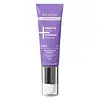What's inside
What's inside
 Key Ingredients
Key Ingredients

 Benefits
Benefits

 Concerns
Concerns

 Ingredients Side-by-side
Ingredients Side-by-side

Water
Skin ConditioningC10-11 Isoparaffin
SolventDimethicone
EmollientPolysilicone-11
Glycerin
HumectantPEG/PPG-19/19 Dimethicone
EmulsifyingC13-16 Isoparaffin
SolventPanthenol
Skin ConditioningAcrylamide/Sodium Acryloyldimethyltaurate Copolymer
Emulsion StabilisingButylene Glycol
HumectantC10-13 Isoparaffin
SolventCaprylyl Glycol
EmollientCarbomer
Emulsion StabilisingCitric Acid
BufferingCucurbita Pepo Seed Extract
Skin ConditioningEthylhexylglycerin
Skin ConditioningIsohexadecane
EmollientLaureth-12
EmulsifyingMaris Aqua
HumectantPalmitoyl Tetrapeptide-7
Skin ConditioningPalmitoyl Tripeptide-1
Skin ConditioningPolysorbate 20
EmulsifyingPolysorbate 80
EmulsifyingSodium Hyaluronate
HumectantTocopherol
AntioxidantPhenoxyethanol
PreservativePotassium Sorbate
PreservativeWater, C10-11 Isoparaffin, Dimethicone, Polysilicone-11, Glycerin, PEG/PPG-19/19 Dimethicone, C13-16 Isoparaffin, Panthenol, Acrylamide/Sodium Acryloyldimethyltaurate Copolymer, Butylene Glycol, C10-13 Isoparaffin, Caprylyl Glycol, Carbomer, Citric Acid, Cucurbita Pepo Seed Extract, Ethylhexylglycerin, Isohexadecane, Laureth-12, Maris Aqua, Palmitoyl Tetrapeptide-7, Palmitoyl Tripeptide-1, Polysorbate 20, Polysorbate 80, Sodium Hyaluronate, Tocopherol, Phenoxyethanol, Potassium Sorbate
Water
Skin ConditioningCetearyl Alcohol
EmollientCaprylic/Capric Triglyceride
MaskingGlycerin
HumectantDimethicone
EmollientBis-Diglyceryl Polyacyladipate-2
EmollientNiacinamide
SmoothingHydrogenated Coco-Glycerides
EmollientCetyl Alcohol
EmollientGlyceryl Stearate
EmollientButyrospermum Parkii Butter
Skin ConditioningPhenoxyethanol
PreservativePEG-75 Stearate
Ceteth-20
CleansingSteareth-20
CleansingChlorphenesin
AntimicrobialTocopheryl Acetate
AntioxidantSodium Ascorbyl Phosphate
AntioxidantEthylhexylglycerin
Skin ConditioningSodium Hyaluronate
HumectantAcrylates/C10-30 Alkyl Acrylate Crosspolymer
Emulsion StabilisingAminomethyl Propanol
BufferingCI 19140
Cosmetic ColorantCI 16035
Cosmetic ColorantWater, Cetearyl Alcohol, Caprylic/Capric Triglyceride, Glycerin, Dimethicone, Bis-Diglyceryl Polyacyladipate-2, Niacinamide, Hydrogenated Coco-Glycerides, Cetyl Alcohol, Glyceryl Stearate, Butyrospermum Parkii Butter, Phenoxyethanol, PEG-75 Stearate, Ceteth-20, Steareth-20, Chlorphenesin, Tocopheryl Acetate, Sodium Ascorbyl Phosphate, Ethylhexylglycerin, Sodium Hyaluronate, Acrylates/C10-30 Alkyl Acrylate Crosspolymer, Aminomethyl Propanol, CI 19140, CI 16035
Ingredients Explained
These ingredients are found in both products.
Ingredients higher up in an ingredient list are typically present in a larger amount.
Dimethicone is a type of synthetic silicone created from natural materials such as quartz.
What it does:
Dimethicone comes in different viscosities:
Depending on the viscosity, dimethicone has different properties.
Ingredients lists don't always show which type is used, so we recommend reaching out to the brand if you have questions about the viscosity.
This ingredient is unlikely to cause irritation because it does not get absorbed into skin. However, people with silicone allergies should be careful about using this ingredient.
Note: Dimethicone may contribute to pilling. This is because it is not oil or water soluble, so pilling may occur when layered with products. When mixed with heavy oils in a formula, the outcome is also quite greasy.
Learn more about DimethiconeEthylhexylglycerin (we can't pronounce this either) is commonly used as a preservative and skin softener. It is derived from glyceryl.
You might see Ethylhexylglycerin often paired with other preservatives such as phenoxyethanol. Ethylhexylglycerin has been found to increase the effectiveness of these other preservatives.
Glycerin is already naturally found in your skin. It helps moisturize and protect your skin.
A study from 2016 found glycerin to be more effective as a humectant than AHAs and hyaluronic acid.
As a humectant, it helps the skin stay hydrated by pulling moisture to your skin. The low molecular weight of glycerin allows it to pull moisture into the deeper layers of your skin.
Hydrated skin improves your skin barrier; Your skin barrier helps protect against irritants and bacteria.
Glycerin has also been found to have antimicrobial and antiviral properties. Due to these properties, glycerin is often used in wound and burn treatments.
In cosmetics, glycerin is usually derived from plants such as soybean or palm. However, it can also be sourced from animals, such as tallow or animal fat.
This ingredient is organic, colorless, odorless, and non-toxic.
Glycerin is the name for this ingredient in American English. British English uses Glycerol/Glycerine.
Learn more about GlycerinPhenoxyethanol is a preservative that has germicide, antimicrobial, and aromatic properties. Studies show that phenoxyethanol can prevent microbial growth. By itself, it has a scent that is similar to that of a rose.
It's often used in formulations along with Caprylyl Glycol to preserve the shelf life of products.
Sodium Hyaluronate is hyaluronic acid's salt form. It is commonly derived from the sodium salt of hyaluronic acid.
Like hyaluronic acid, it is great at holding water and acts as a humectant. This makes it a great skin hydrating ingredient.
Sodium Hyaluronate is naturally occurring in our bodies and is mostly found in eye fluid and joints.
These are some other common types of Hyaluronic Acid:
Learn more about Sodium HyaluronateWater. It's the most common cosmetic ingredient of all. You'll usually see it at the top of ingredient lists, meaning that it makes up the largest part of the product.
So why is it so popular? Water most often acts as a solvent - this means that it helps dissolve other ingredients into the formulation.
You'll also recognize water as that liquid we all need to stay alive. If you see this, drink a glass of water. Stay hydrated!
Learn more about Water